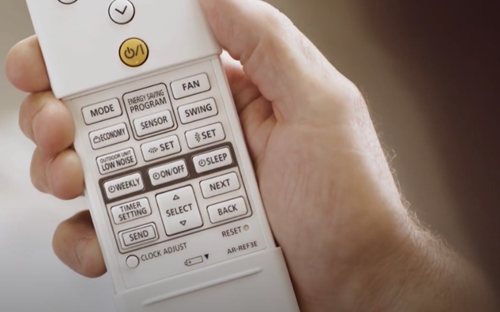What is The Best Heat Pump / Air Conditioning Temperature for Sleeping?

Using a heat pump / air conditioner while sleeping has numerous benefits when it comes to personal health and getting a good night’s sleep. Finding the ideal air conditioning temperature for sleeping may assist in enabling you to enjoy deeper rest and wake up in the morning feeling refreshed and comfortable..
Our sleep quality greatly influences our ability for the body to produce melatonin to begin entering a sleep-wake cycle. This is also known as the ‘circadian rhythm’ which is a 24-hour internal clock running in the background of the human brain, which cycles between feeling sleepy and being alert at regular intervals.
Your body’s internal temperature will begin to release warmth about the time you fall asleep and will then continue to cool down until it reaches a typically low point early in the morning, often just before sunrise. During a sleep cycle, the body’s blood vessels will expand as it begins to self-cool through the skin and you may notice select parts of your body such as hands and feet get warmer. This is how your body allows heat to escape, to help reduce core temperature.
Benefits of Air Conditioning for Sleep
There are a number of health benefits to running a heat pump overnight, including improved sleep quality and enhanced physical and mental wellbeing. To ensure the best possible sleep, it is recommended to have your heat pump serviced regularly and to use efficient operating modes that tailor use of the unit to your routine.
Maximises comfort
Using a heat pump / air conditioner in your bedroom helps maintain your body’s natural preferred temperature for sleeping, preventing overheating and night sweats. By creating a cooler environment, an air conditioner supports the body’s transition into deeper sleep, enabling you to wake up refreshed.
Improves air quality
The filters available in selected i heat pumps / air conditioners help reduce the number of pollutants present in indoor spaces. By removing stagnant air, dust, pollen and mould spores from your bedroom, heat pumps create a safer environment, particularly for those living with allergies or respiratory conditions.
Lowers humidity levels
Stuffiness is one of the biggest factors that prevents deep sleep. Heat pumps / air conditioners help maintain an ideal level of indoor humidity, removing excess moisture and creating a crisper, drier environment. A reduction in humidity also improves breathability, further improving air quality for those with health conditions.
Promotes undisturbed sleep
Heat pumps and air conditioners promote deep sleep in several ways. The soft hum of the unit acts as white noise, while the continual operation of a heat pump / air conditioner helps prevent temperature fluctuations. Using a heat pump / air conditioner also enables you to sleep with the windows closed, reducing noise from barking dogs, traffic and other external disturbances.
Alleviates allergies and congestion
Sleeping with an air conditioner on can reduce the severity or likelihood of several conditions, including sinus congestion and skin irritations. Both conditions can be worsened or caused by humid indoor conditions. Using a heat pump / air conditioner also prevents dust from building up, reducing the chance of allergies from flaring at night.
The Best Heat Pump / Air Conditioning Temperature for Sleeping
The ideal heat pump / air conditioning temperature for sleeping varies between 15 and 22 degrees. Infants and young children, meanwhile, may have difficulty regulating their body temperature, and should sleep in a more temperate climate of between 19-25 degrees.
A heat pump / air conditioner can assist with temperature management in the bedroom, by using timer settings. This feature allows you to control when the heat pump is operating, and at a set temperature. You can use timers to have the system turn on before you wake up or switch off just after you think you will have fallen asleep to help create a comfortable room for a good night’s sleep.
What is the Best Air Conditioning Unit for a Bedroom?
Fujitsu General offers a wide range of heat pump and air conditioning units for bedrooms, including wall mounted, ducted, floor and cassette designs. You may choose a small wall mounted unit for your bedroom or you may prefer a ducted system for whole home heating and cooling. Floor mounted units are an excellent choice in situations where wall space is limited and a low-profile solution is needed. Compact cassette models are discreet with a non-intrusive grille design that sits level with the ceiling.
Many of our systems have optional Smart Climate Control through advanced Wi-Fi technology, enabling remote control and personalisation of the system to your preferences and schedule.
To learn more about which heat pump / air conditioning unit is best suited to use in your home, visit the Fujitsu Assist Product Selector Tool and compare different models in the range.
Enjoy a Good Night’s Rest with Fujitsu General
Air conditioning units for bedrooms promote a good night’s sleep by regulating your body’s internal temperature and improving indoor air quality. Setting your unit to the ideal heat pump / air conditioning temperature for sleeping creates a consistent, comfortable and cool environment that promotes deep sleep.
Fujitsu General has a wide variety of heat pumps / air conditioning units for bedrooms, suiting numerous home and room designs. Our experts can assist you in selecting, installing split system air conditioners and maintaining the best units for your home to create a comfortable environment year-round for your family. Visit the Fujitsu Help Centre to learn more about the best air conditioning units for bedrooms, or contact us directly to find your nearest stockist.





